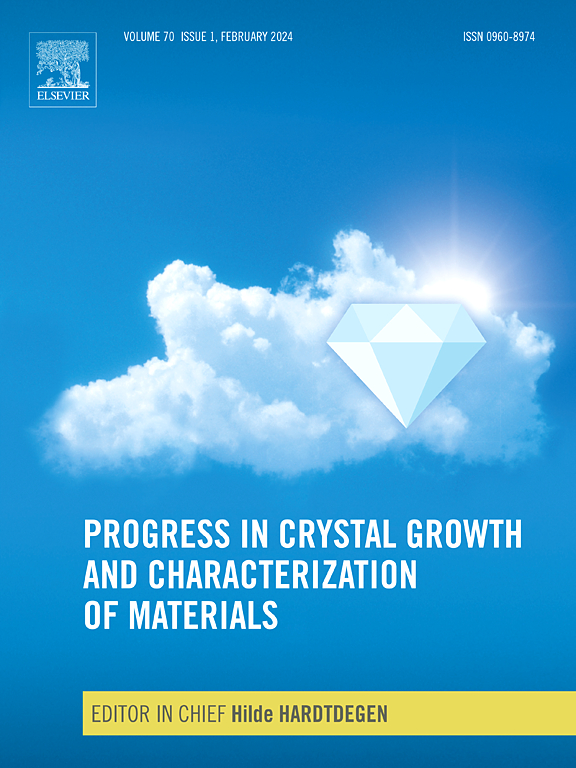Bragg diffraction imaging characterization of crystal defects in GaN (0001) substrates: Comparison of the growth method and the seed approach
IF 1.9
2区 材料科学
Q1 CRYSTALLOGRAPHY
Progress in Crystal Growth and Characterization of Materials
Pub Date : 2025-05-08
DOI:10.1016/j.pcrysgrow.2025.100668
引用次数: 0
Abstract
We investigate the defect structure of gallium nitride (GaN) substrates grown by hydride vapor phase epitaxy (HVPE) and ammonothermal method, with emphasis on the seeding approach (“foreign seed” or “native seed”). X-ray Bragg diffraction imaging techniques (laboratory X-ray Lang topography (L-XRT) and synchrotron monochromatic rocking curve imaging (RCI)) were used to study the defects of the GaN substrates. The efficiency of the in-process L-XRT method, whereas being strongly dependent on the structural perfection of the crystals, is important because it provides a good overview of the defect structure for entire substrates. But it remains qualitative, or semi-quantitative. RCI, on the other hand, allows obtaining complete quantitative information about lattice misorientation and distortion with sub-µm resolution. The contrast of the diffraction images of defects such as grain boundaries, dislocations, dislocation bundles, planar defects and others, is discussed, with emphasis on the influence of threading dislocation density on the contrast of the Bragg diffraction imaging. We complemented the diffraction studies with defect selective etching analyses and, to determine the level of impurities in the GaN substrates, by time-of-flight secondary ion mass spectrometry (ToF-SIMS). The main finding of this study is that a native seed approach is essential for crystallizing GaN with high structural perfection and low threading dislocation density. This is true whether the GaN crystals are grown by HVPE or ammonothermal methods. A potential route to low-defect, low-impurity GaN substrates is outlined as a fundamental element for realizing GaN-based devices with high performance, life-time, and reliability.

GaN(0001)衬底中晶体缺陷的Bragg衍射成像表征:生长法和种子法的比较
我们研究了氢化物气相外延(HVPE)和氨热法生长的氮化镓(GaN)衬底的缺陷结构,重点研究了播种方法(“外来种子”或“本地种子”)。利用x射线布拉格衍射成像技术(实验室x射线朗形貌(L-XRT)和同步加速器单色摇摆曲线成像(RCI))研究了GaN衬底的缺陷。过程中L-XRT方法的效率,虽然强烈依赖于晶体结构的完美性,但很重要,因为它提供了整个衬底缺陷结构的良好概述。但它仍然是定性的或半定量的。另一方面,RCI可以在亚微米分辨率下获得关于晶格取向错误和畸变的完整定量信息。讨论了晶界、位错、位错束、平面缺陷等缺陷的衍射图像对比,重点讨论了螺纹位错密度对Bragg衍射成像对比度的影响。我们用缺陷选择性蚀刻分析来补充衍射研究,并通过飞行时间二次离子质谱法(ToF-SIMS)来确定GaN衬底中的杂质水平。本研究的主要发现是原生种子方法对于具有高结构完美性和低螺纹位错密度的GaN的结晶是必不可少的。无论氮化镓晶体是用HVPE法还是氨热法生长的,都是如此。低缺陷、低杂质GaN衬底的潜在途径是实现具有高性能、寿命和可靠性的GaN基器件的基本要素。
本文章由计算机程序翻译,如有差异,请以英文原文为准。
求助全文
约1分钟内获得全文
求助全文
来源期刊

Progress in Crystal Growth and Characterization of Materials
工程技术-材料科学:表征与测试
CiteScore
8.80
自引率
2.00%
发文量
10
审稿时长
1 day
期刊介绍:
Materials especially crystalline materials provide the foundation of our modern technologically driven world. The domination of materials is achieved through detailed scientific research.
Advances in the techniques of growing and assessing ever more perfect crystals of a wide range of materials lie at the roots of much of today''s advanced technology. The evolution and development of crystalline materials involves research by dedicated scientists in academia as well as industry involving a broad field of disciplines including biology, chemistry, physics, material sciences and engineering. Crucially important applications in information technology, photonics, energy storage and harvesting, environmental protection, medicine and food production require a deep understanding of and control of crystal growth. This can involve suitable growth methods and material characterization from the bulk down to the nano-scale.
 求助内容:
求助内容: 应助结果提醒方式:
应助结果提醒方式:


